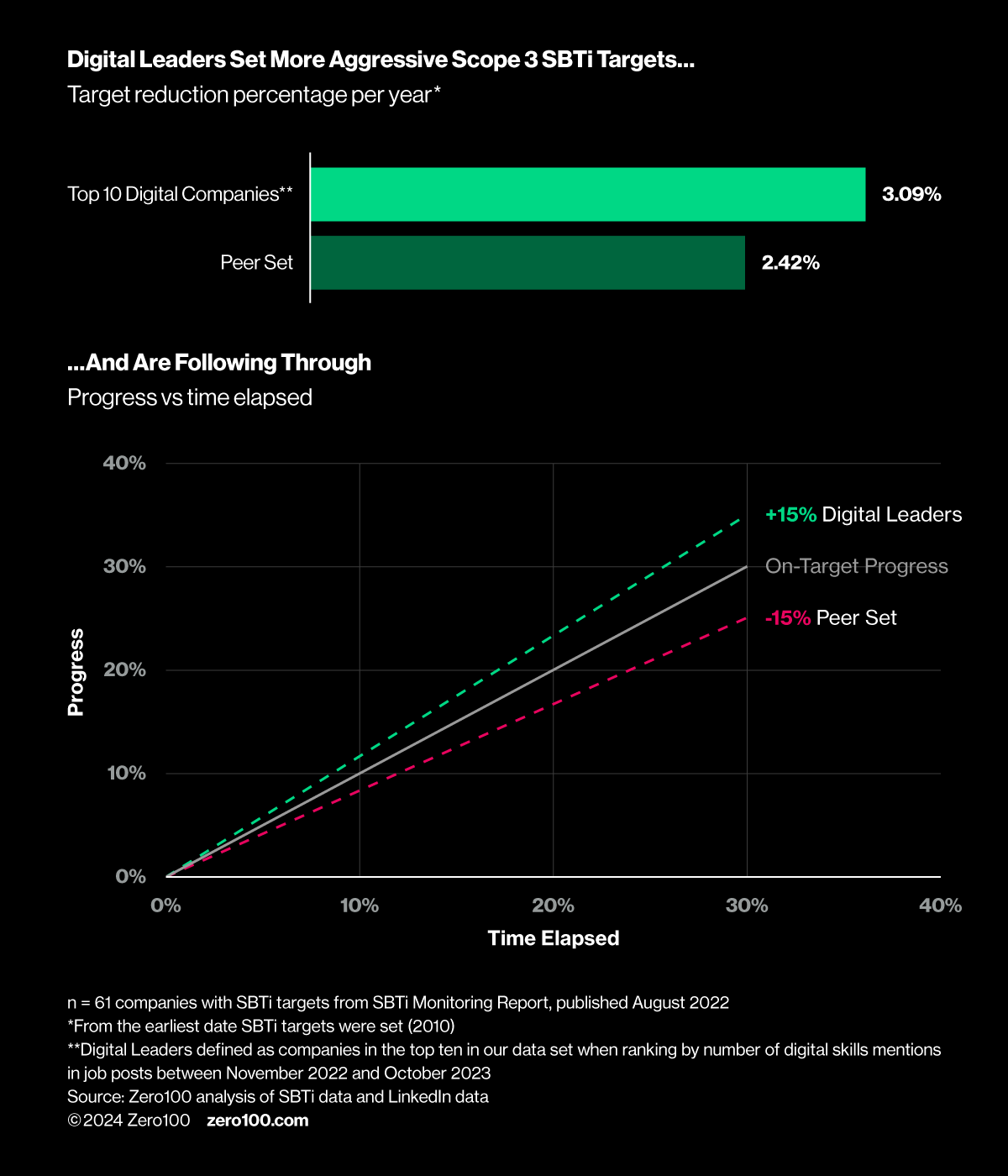

Digital Leaders Set – and Hit – More Ambitious SBTi Targets
Companies that actively prioritize hiring digitally savvy talent have set themselves more aggressive carbon reduction targets and are making significantly more progress toward those targets as compared to companies less focused on hiring digital talent. Determining and specifying the technical skills you need to execute key carbon initiatives can make all the difference to your organization’s efforts and results.
Key Takeaways
-
1
The top ten companies in our data set of 175 B2C and B2B companies who have the highest percentage of LinkedIn job posts mentioning digital skills have more ambitious carbon reduction goals, targeting a yearly cut of more than 3% vs the rest of our data set, who target less than 2.5%.
-
2
In overall carbon emissions, from base year through to target deadline, these same digitally savvy companies aim to decrease emissions by 5% more than the rest of our data set (34% vs 29%).
-
3
Over the time elapsed from base year to last reported progress update, the same top digital companies are, on average, +14% ahead of where they should be on reaching their targets. The rest of the set is behind on progress by, on average, -15%.
As outlined in our last analysis of SBTi data, only 34% of B2B and B2C companies in our data set have set Scope 3 SBTi targets, and, of those, only 45% have reported progress. Zeroing in on those who have made progress, 23% are ahead of where they need to be. The numbers tell us what we might have already guessed: tackling carbon emissions in business operations is a big challenge. Companies leading the pack are taking two primary steps to ensure they can take on the challenge: 1) taking accountability by setting SBTi targets and 2) prioritizing hiring digitally capable, sustainability-focused talent.
The companies with the highest percentage of LinkedIn job posts mentioning digital skills have demonstrated confidence and a willingness to take accountability when it comes to sustainability, setting yearly reduction targets 28% more ambitious than the rest – aiming to reduce emissions by 3.09% per year, compared to 2.42%. Focusing on time elapsed, from base year (on average, 2018) to last reported progress update, these top companies have exceeded their target (so far) by 14%. For example, Heineken N.V. set a Scope 3 reduction target of 21% between 2018 and 2030. To meet this target within 12 years, they need to reduce carbon by 1.75% per year. Within three years (their last reported progress date), Heineken have reduced emissions by, on average, 2.5% per year, meaning they are +18% ahead on meeting their target. Digital laggards, on the other hand, are 15% behind on where they should be.
We also found that companies that actively prioritize hiring digitally savvy talent have set themselves more aggressive targets and are making significantly more progress toward those targets.

To get to where they need to be, the companies lagging behind must fully embrace digital transformation. An example of a successful implementation of digital solutions targeting decarbonization comes from Hyundai and Kia, who, in August 2023, launched an AI-enabled blockchain-based system for cooperative carbon emissions control called SCEMS (Supplier CO2 Emission Monitoring System). SCEMS allows suppliers to collect the carbon data they need to accurately monitor and successfully reduce and predict future emissions. They have shifted from authenticating spare parts using private blockchain to adopting public DLT for SCEMs through Hedera. The decision to open-source the technology underscores their commitment to driving industry-wide change.
But being able to embrace digital transformation means building out technical capabilities through targeted recruiting. Homing in on selected skills can make the difference. For example, proficiency in blockchain might bolster carbon accounting initiatives like Hyundai and Kia’s SCEMS, or AI might aid in implementing material traceability initiatives like VF’s Sourcemap. Alongside adding sustainability keywords such as “carbon accounting” and “decarbonization,” customizing job listings will help build teams equipped with the knowledge, confidence, and passion necessary to execute decarbonization strategies within any given supply chain function.
More and more supply chain organizations are committing to carbon reduction targets and taking accountability for both successes and failures. To stay ahead of the curve and to accurately report on progress and execute on initiatives, companies should make an effort to find the right talent to successfully embrace and employ tech solutions – whether external partners or in-house teams.
To see a different data cut or to dig deeper into this topic, reach out to our Head of Research Analytics, Cody Stack, at Cody.Stack@zero100.com.
Methodology
Zero100’s proprietary data and analytics are a combined effort between our data scientists and research analysts. We provide data-first insights matched with our own research-backed points of view and bring this analysis to life via real-world case examples being led by supply chain practitioners today.
For this study, we analyzed SBTi data from 175 B2B and B2C companies and 2.8 million LinkedIn job listings. Our analysis categorizes listings based on mentions of specific digital skills within job titles and descriptions.